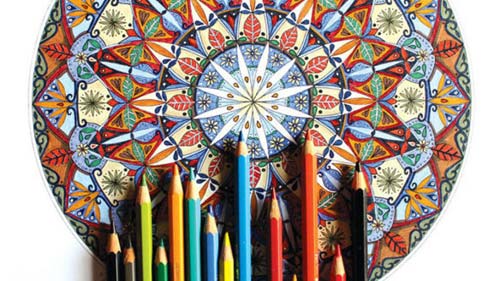Colouring in for adults is the latest craze to sweep the world. Where once stores tried to lure you in with tables laid out with cookbooks or colourful stationery, now they seek your attention with an assortment of colouring in books. In fact, we have gone from being able to access just a tiny selection available at specialist shops to now being able to buy them in the supermarket.
Not only are they being sold as something to bring out our creativity or even our childhood abandon and sense of fun, mostly they seem to centre on Mindfulness. The idea being, that if you are engrossed in colouring in, then you are doing something good for your mental health, soul and general being. Colouring in for mindfulness is the new mantra attracting people to an easy to do activity with the promise of help for coping with the daily grind.
But is This Accurate?
Is colouring actually mindfulness? Or is it simply a marketing ploy to try and get people to stockpile colouring books with the idea that using them will fulfil a role that would normally be achieved through study and practise?
What is Mindfulness?
Mindfulness is a skill set that helps people deal with their lives, anxieties and other issues. It is used in Acceptance and Commitment Therapy (ACT) and has its roots in Buddhism. Dr Russ Harris is a medical practitioner, psychotherapist, and executive coach and is the author of the best-selling book ‘The Happiness Trap’ which is the go-to guide for learning ACT.
Mindfulness is a Form of Attention Training.
“Mindfulness involves learning how to flexibly focus your attention to important aspects of your here-and-now experience: aspects of your inner world, external world, or both. Mindfulness includes qualities of attention such as curiosity and openness.” He summarises it thus, “Mindfulness means paying attention, with openness, curiosity, and flexibility.”
So no one activity is mindfulness in itself. You can practice anything mindfully. In fact, ACT encourages the use of mindfulness techniques when doing mundane or unpleasant activities as well as pleasant ones. The idea is to be present in the moment. The more you practise mindfulness in every day activities the better you’ll use this same skill to help you through challenging or difficult situations.
“Cooking, cleaning, making love, playing guitar, having a shower, working out at the gym, driving your car, playing with your kids: these are all activities that can be done mindfully … or not.” Dr Harris says.
Back To Colouring In
So colouring in mindfully may seem like a great idea but what you would be doing would be counter to actually enjoying colouring in. If you are focussing on the sounds, movements of your hand etc then this would take the joy out of colouring. But that is all okay, it doesn’t make colouring in a bad thing, it simply means that it might not be the best activity to practise mindfulness with.
Another Example: Reading
The same goes with reading. If we practised mindfulness when reading a book then we would be concentrating on the feel of the page against our fingers as we turn it, the placement of our head against the cool leather headrest or soft pillow, the whooshing sound of the page turning, perhaps even the feel of our glasses on the bridge of our nose. When the intoxicating new book smell takes us back to the first book we fell in love with, then we would have to stop and refocus rather than continue to dwell on the happy memory. All this would mean we would be unable to become immersed in the characters and the world they inhabit which is what is inherently enjoyable about reading.
Enjoyable Activities ARE NOT Mindfulness
So enjoyable activities and mindfulness don’t necessarily go together. I’m not here to knock colouring in, because I really enjoy it, just as I enjoy reading. I cannot draw and so colouring in seems to satisfy my need to be creative with my hands where pens, pencils, crayons, charcoal etc. can be used to create something beautiful. But enjoying something or even finding an activity relaxing is not mindfulness. “Unfortunately, many people equate mindfulness with absorption or relaxation. But they are not one and the same. For example, we can be absorbed in reading a book or watching a movie – but these are rarely if ever mindful activities,” says Dr Harris.
The Marketing Ploy
So why sell colouring in as mindfulness? It would seem that it is a gimmick. Tell people they can help to heal themselves emotionally simply by doing something fun and simple like colouring in and people will sign up in droves. Many of us have issues of some sort from full-blown anxiety or depression to being stressed about life or work. So the idea that we can somehow fix it so simply is of course attractive. But like the weight loss industry and beauty industry we need to remember that selling a quick fix works for the companies doing the selling by lining their pockets, whilst the people buying realise that actually most things that are beneficial require some actual work and practice. There are no short cuts to emotional health.
Tl;dr
Colouring in, like reading a good book or watching a movie can be wonderful, enjoyable activities. They can even be relaxing and thus can help us feel better to some degree. If you enjoy colouring in then please keep doing it, even beyond the time that the trendy people tell us its old news.
But if you want to learn to practise mindfulness, and there are certainly many benefits to doing so, then forget the colouring in. Instead discover what it truly is, learn about it, practice it, and keep practising it. Once you learn this skill it will be invaluable. But like most things in life that are beneficial it will take time, work and effort, but it will be worth it.

![5 Reasons You Should Travel Alone Airplane [image source: chau nguyen/ http://thedevilhatessweatpants.blogspot.com.au ], crowd ink, crowdink, crowdink.com, crowdink.com.au](https://crowdink.com/wp-content/uploads/2016/08/Chau-airplane-218x150.jpg)




























![5 Reasons You Should Travel Alone Airplane [image source: chau nguyen/ http://thedevilhatessweatpants.blogspot.com.au ], crowd ink, crowdink, crowdink.com, crowdink.com.au](https://crowdink.com/wp-content/uploads/2016/08/Chau-airplane-100x70.jpg)


